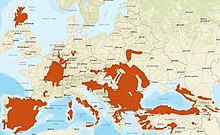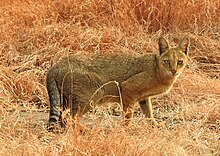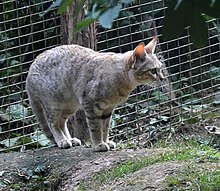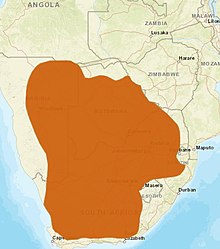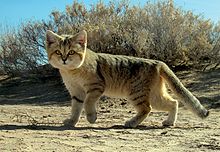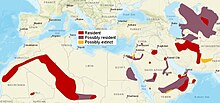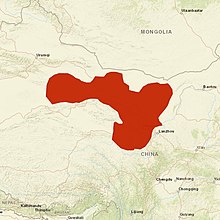
Felidae is the family of mammals in the order Carnivora colloquially referred to as cats. A member of this family is also called a felid. The term "cat" refers both to felids in general and specifically to the domestic cat.
Panthera is a genus within the family Felidae, it is one of two extant genera in the subfamily Pantherinae, and contains the largest living members of the cat family. There are 5 living species, the tiger, jaguar, lion, leopard and snow leopard and a number of extinct species.

The wildcat is a species complex comprising two small wild cat species: the European wildcat and the African wildcat. The European wildcat inhabits forests in Europe, Anatolia and the Caucasus, while the African wildcat inhabits semi-arid landscapes and steppes in Africa, the Arabian Peninsula, Central Asia, into western India and western China. The wildcat species differ in fur pattern, tail, and size: the European wildcat has long fur and a bushy tail with a rounded tip; the smaller African wildcat is more faintly striped, has short sandy-gray fur and a tapering tail; the Asiatic wildcat is spotted.

The sand cat is a small wild cat that inhabits sandy and stony deserts far from water sources. With its sandy to light grey fur, it is well camouflaged in a desert environment. Its head-and-body length ranges from 39–52 cm (15–20 in) with a 23–31 cm (9.1–12.2 in) long tail. Its 5–7 cm (2.0–2.8 in) short ears are set low on the sides of the head, aiding detection of prey moving underground. The long hair covering the soles of its paws insulates its pads against the extreme temperatures found in deserts.
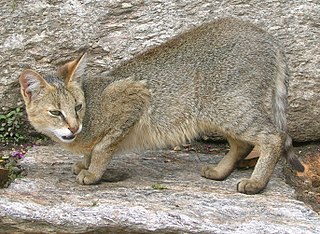
The jungle cat, also called reed cat, swamp cat and jungle lynx, is a medium-sized cat native to the Middle East, the Caucasus, South and Southeast Asia and southern China. It inhabits foremost wetlands like swamps, littoral and riparian areas with dense vegetation. It is listed as Least Concern on the IUCN Red List, and is mainly threatened by destruction of wetlands, trapping and poisoning.
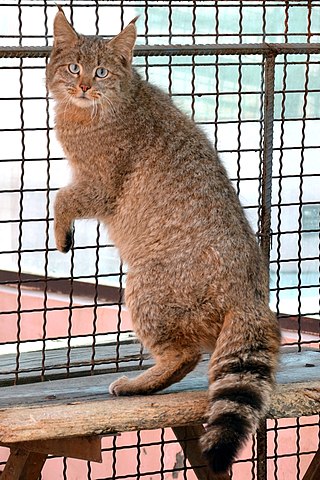
The Chinese mountain cat, also known as Chinese desert cat and Chinese steppe cat, is a small wild Felis species with sand-coloured fur, faint dark stripes on the face and legs and black tipped ears. It is endemic to the Tibetan Plateau of western China, where it lives in grassland above elevations of 2,500 m (8,200 ft). It has been listed as vulnerable on the IUCN Red List since 2002.

Catopuma is a genus of the Felidae containing two small cat species native to Southeast Asia, the Asian golden cat and the bay cat . Both have similar pelage, with solid reddish brown coloration on their backs and darker markings on the head. They also exhibit colour morphs ranging from various browns to gray to black. The Asian golden cat occurs from northeast India to Sumatra, and the bay cat lives only on Borneo. Both inhabit forested areas.

Prionailurus is a genus of spotted, small wild cats native to Asia. Forests are their preferred habitat; they feed on small mammals, reptiles and birds, and occasionally aquatic wildlife.
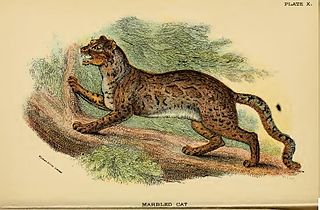
Pardofelis is a genus of the cat family Felidae. This genus is defined as including one species native to Southeast Asia: the marbled cat. Two other species, formerly classified to this genus, now belong to the genus Catopuma.
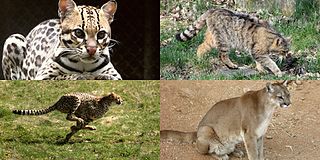
Felinae is a subfamily of the Felidae and comprises the small cats having a bony hyoid, because of which they are able to purr but not roar. Other authors have proposed an alternative definition for this subfamily, as comprising only the living conical-toothed cat genera with two tribes, the Felini and Pantherini, and excluding the extinct sabre-toothed Machairodontinae.

Leopardus is a genus comprising eight species of small cats native to the Americas. This genus is considered the oldest branch of a genetic lineage of small cats in the Americas whose common ancestor crossed the Bering land bridge from Asia to North America in the late Miocene.

The Pantherinae is a subfamily of the Felidae; it was named and first described by Reginald Innes Pocock in 1917 as only including the Panthera species. The Pantherinae genetically diverged from a common ancestor between 9.32 to 4.47 million years ago and 10.67 to 3.76 million years ago.
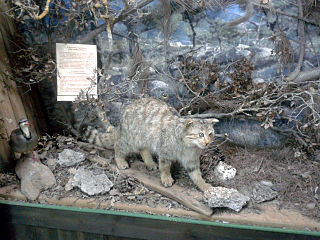
The Cretan wildcat is a member of the genus Felis that inhabits the Greek island of Crete. Its taxonomic status is unclear at present, as some biologists consider it probably introduced, or a European wildcat, or a hybrid between European wildcat and domestic cat. It was previously considered a separate subspecies of wildcat as Felis silvestris cretensis.

The European wildcat is a small wildcat species native to continental Europe, Scotland, Turkey and the Caucasus. It inhabits forests from the Iberian Peninsula, Italy, Central and Eastern Europe to the Caucasus. Its fur is brownish to grey with stripes on the forehead and on the sides and has a bushy tail with a black tip. It reaches a head-to-body length of up to 65 cm (26 in) with a 34.5 cm (13.6 in) long tail, and weighs up to 7.5 kg (17 lb).

The African wildcat is a small wildcat species with sandy grey fur, pale vertical stripes on the sides and around the face. It is native to Africa, West and Central Asia, and is distributed to Rajasthan in India and Xinjiang in China. It inhabits a broad variety of landscapes ranging from deserts to savannas, shrublands and grasslands.

The Corsican wildcat is an isolated cat population of uncertain taxonomic status that has been variously regarded as a separate species of its own, a subspecies of the African wildcat, or a population of feral house cats that were introduced to Corsica around the beginning of the first millennium.
The Caucasian wildcat is a European wildcat subspecies that inhabits the Caucasus Mountains and Turkey.

The Southern African wildcat is an African wildcat subspecies native to Southern and Eastern Africa. In 2007, it was tentatively recognised as a distinct subspecies on the basis of genetic analysis. Morphological evidence indicates that the split between the African wildcat subspecies in Africa occurred in the area of Tanzania and Mozambique.

Caracal is a genus in the subfamily Felinae of the family Felidae. It was proposed by John Edward Gray in 1843 who described a skin from the Cape of Good Hope in the collection of the Natural History Museum, London. Historically, it was considered to be a monotypic genus, consisting of only the type species: the caracal C. caracal.




